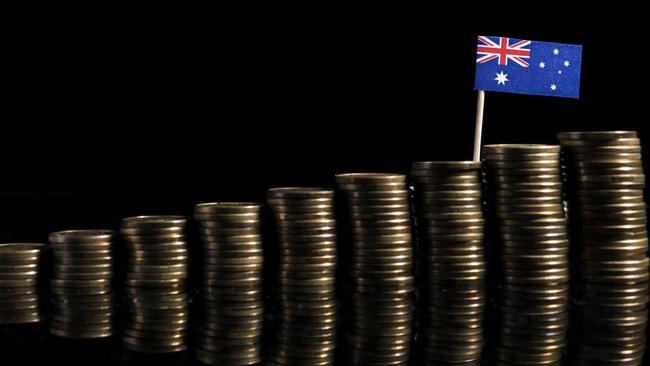What Australia’s $1 trillion national debt will mean for you
Forecasts for the Federal Government’s debt sound frightening, but this is what its march towards $1 trillion really means.
Australia’s national debt will hit $1 trillion – that’s one thousand billion dollars – at some point next year, according to this week’s federal budget.
Just 12 years ago, this debt was zero.
For many average Australians, $1 trillion is a number that seems very scary, and dangerous. Financial commentators have complained about the big-spending Budget’s impact on future generations, but economists have generally accepted it as something that needs to be done.
While Treasurer Josh Frydenberg said debt as a percentage of our economy compared favourably with the US, Britain and Japan, it still must be managed and the interest bill paid.
SHOULD YOU BE SCARED?
PwC Australia chief economist Jeremy Thorpe projects the debt to grow to $33,251 for every man, woman and child by 2024-25. And the interest bill on that debt would be $581 per person.
“If you are paying $581 it doesn’t sound too terrible, but if you add that up for every person there’s an opportunity cost to it,” Mr Thorpe said.
“If we didn’t have the debt, we could be doing other things with that money.”
However, the debt is not owed by individuals, and the government has an endless supply of income – from taxpayers – to make repayments.

“People are not going to have someone knock at their door saying ‘I want your $33,000’ – they’re not personally liable,” Mr Thorpe said.
“The national debt is higher than we have experienced in Australia, but in relative terms we are still nowhere near the national debt for other advanced economies. But as long as we are growing, we shouldn’t be too concerned.”
Growing economies shrink debt naturally, just like rising house prices make a mortgage taken out 20 years ago seem small.
DEBT AND DEFICIT EXPLAINED
Gross debt is the total value of Australian government securities – such as treasury bonds – on issue and owned by investors, banks and super funds. Net debt is smaller because it subtracts government financial assets such as cash and loans from the gross number.
The Budget forecasts gross debt to hit $1.06 trillion in 2022-23, growing to $1.5 trillion by the end of the decade. Net debt is forecast to reach $835 billion in 2022-23 and $981 billion by 2024-25.
A deficit is the annual shortfall when government revenue doesn’t cover spending.
For 2020-21 the budget deficit is an estimated $161 billion, for 2021-22 it’s forecast to be $106.6 billion and for 2022-23 it’s $99.3 billion.
The Budget projects deficits out to at least 2031-32, when it will still be spending 1.3 per cent more money than it brings in.
POTENTIAL PROBLEMS
Australian’s debt explosion of the past decade was largely sparked by two huge economic shocks – the Global Financial Crisis and the coronavirus pandemic.
The big potential problem is what happens when the global economy nosedives again, and BetaShares chief economist David Bassanese said the big debt would make handling that difficult.
“It means we will have less budget leeway to spend our way of trouble should another economic crisis come along in the next few years,” he said.
“Even without a new crisis, it will also constrain the ability of future governments to spend money in other areas in decades to come.
“At the moment the debt appears manageable, but it will be less manageable in the future if interest rates globally move back to more historically normal levels.”
Mr Bassanese said history suggested governments had a hard time getting budgets back into surplus “and now we’re not even pretending that we still care”.
“The political will to keep debt in check appears to have been lost,” he said.
PwC’s Mr Thorpe said it was easy for governments to get into debt but much harder to repair budgets.
“We have locked in higher spending and that means it’s harder to get it down, and future generations will have to pay for it.”

DON’T TRY THIS AT HOME
LifeSherpa founder and CEO Vince Scully said households should never copy governments by running regular deficits.
“Governments can borrow money forever, as long as they can maintain the confidence of capital markets,” he said.
This explained why the US government had only delivered two budget surpluses in more than 30 years, Mr Scully said.
“But if you’re a household you should be running a surplus every year on average.”
IS HUGE DEBT THE RIGHT MOVE?
Debt is often measured as a percentage of the economy (GDP) and this puts Australia’s current position well below where it was in World War Two, but similar to World War One and the Great Depression.
CommSec chief economist Craig James said the budget deficit as a proportion of GDP was the biggest since 1945.
“While the economy is now expanding, the Government argues that now is not the time for austerity – or actively seeking to lower the budget deficit and reduce debt,” he said.
“With interest rates close to zero, maintaining or lifting debt can produce returns that more than offset debt costs.”
AMP Capital chief economist Shane Oliver said the government had recently been borrowing money at an interest rate near 1 per cent for 10 years.
“Avoiding fiscal austerity and focusing on growing the economy is the right thing to do at present,” he said.
“Economic growth will help ease the debt burden but – in the absence of a post-WWII style population and immigration boom – it’s unlikely to be anywhere near enough to achieve anything like the rapid post-WWII decline seen in the debt to GDP ratio.”




To join the conversation, please log in. Don't have an account? Register
Join the conversation, you are commenting as Logout